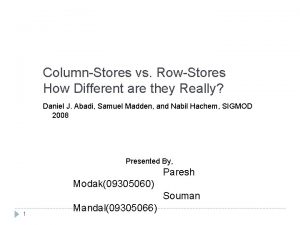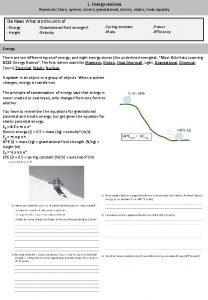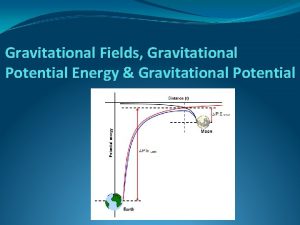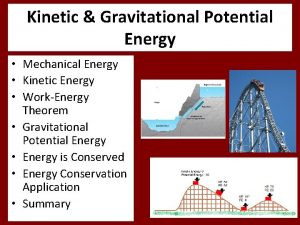Energy revision Keywords Store system kinetic gravitational kinetic




- Slides: 4

Energy revision Keywords: Store, system, kinetic, gravitational, kinetic, elastic, heat capacity Do Now: What are the units of -Energy -Height -Gravitational field strength? -Velocity -Spring constant -Mass -Power -Efficiency Energy There are ten different types of energy, and eight energy stores (the underlined energies): “Most Kids Hate Learning GCSE Energy Names”. The first letters stand for Magnetic, Kinetic, Heat (thermal), Light, Gravitational, Chemical, Sound, Electrical, Elastic, Nuclear. A system is an object or a group of objects. When a system changes, energy is transferred. The principle of conservation of energy says that energy is never created or destroyed, only changed from one form to another. You have to remember the equations for gravitational potential and kinetic energy, but get given the equation for elastic potential energy. Ek = 0. 5 x m x v 2 Kinetic energy (J) = 0. 5 × mass (kg) × velocity 2 (m/s) Ep = m x g x h GPE (J) = mass (kg) × gravitational field strength (N/kg) × height (m) Ee = ½ x k x e 2 EPE (J) = 0. 5 × spring constant (N/m) × extension 2 (m)

Power and efficiency Power is a measured of how much energy is being used/work done is transferred per second. P=E÷t Power (W) = Energy (J) ÷ time (s) P=W÷t Power (W) = work done (J) ÷ time (s) During the process of an energy transfer, energy is usually lost (mostly in the form of thermal and sound energy). Efficiency is a measure of how usefully the energy/power is transferred. Efficiency = useful power output (W) ÷ total power in (W) Efficiency = useful energy output (J) ÷ total energy in (J) We want to reduce energy unwanted energy transfers. We can do this by lubrication (for example on the wheels of a bike), or reduce energy loss in the home by: • Installing double glazing. • Installing cavity wall insulation (which decreases thermal conductivity of the wall and reduces convection also). • Using loft insulation and draught excluders.

Specific heat capacity When a substance is changing temperature, the energy change can be calculated by using ΔE= m x c x Δϑ. The specific heat capacity is the energy needed to heat up 1 kg of a substance by 1 degree. Required practical 1 gets us to measure the specific heat capacity of a material. To do this we: -Use a metal block with two holes in it (one for heater and one for thermometer to measure the temperature. -Use a balance to measure the mass of the metal block. -Use a power pack to supply energy to the metal block, a Joulemeter can be used to measure thermal energy going into the block. (Note: you can use an ammeter, voltmeter and stopwatch instead of a Joulemeter). -If we have measured the mass, energy change, and temperature change then we can use ΔE= m x c x Δϑ to calculate the specific heat capacity. Stretch: Calculate the specific heat capacity of the copper block from the information in the diagram.

Energy Resources Renewable energy resources are renewed. They do not run out. Examples include; tidal, wave, geothermal, wind and solar. Non-renewable energy resources do run out. They are fossil fuels (coal, oil and gas) and nuclear. Nonrenewables generally work by heating water in a boiler until it turns to steam. This steam is highly pressurised and turns the blades of a turbine. This turbine then turns a generator which converts kinetic energy into electrical energy. Each method of generating electricity has advantages and disadvantages. Burning fossil fuels creates carbon dioxide which leads to global warming; but they generate electricity reliably. Wind and solar power are unreliable but do not generate carbon dioxide and once built are cheap to run.







